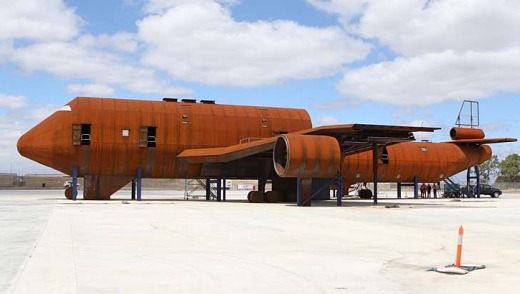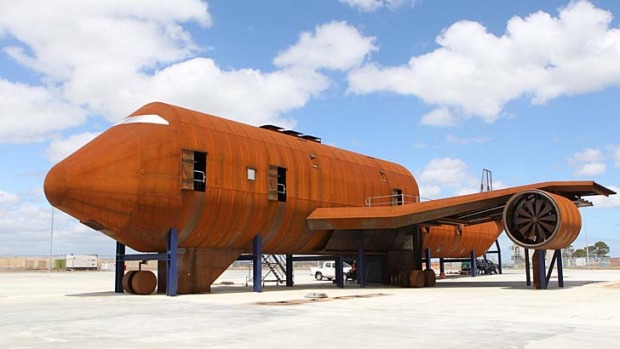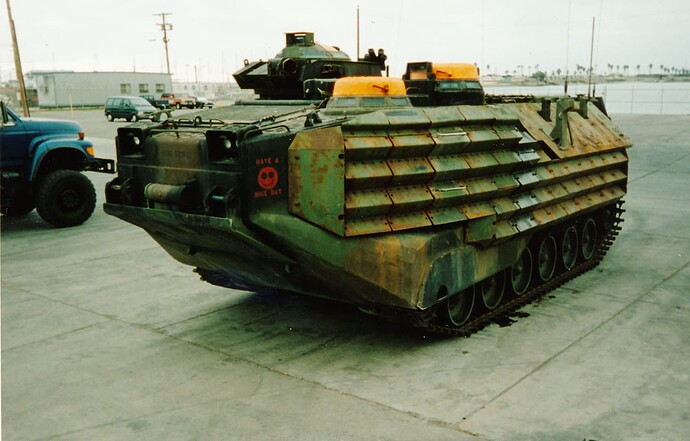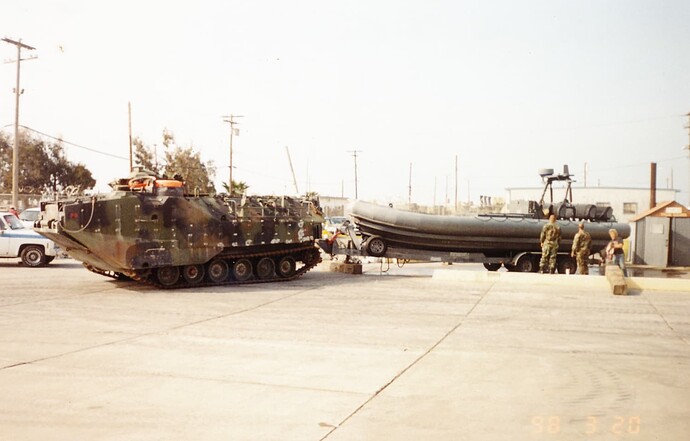Reminds me of a Sunderland that someone posted on the Airfix Facebook page a while back.
Complete with RED-BROWN rust streaks all over the fuselage. Besides from that, it was very nicely done and had a lot of scratch built detail.
When it was pointed out by a couple of people that aeroplanes are made from aluminium and don’t rust red, they were accused of being rivet counters. Including from the builder, who took it far too personally and refused to accept the constructive criticism.
I like rusted planes they look cool. For instance…


I agree, vehicles with a coating of dust or dirt and on the move will show very little rust. I believe today there are so many products on the modeling market. Rust, chipping, etc. and so many magazines and websites promote these products, which can obtain nice results but is it accurate? I’ve seen so many models over the past years that have so much rust and chipping that it’s just not realistic for a combat vehicle. Look at B&W pics or color if you can and I see very little rust unless it’s subtle on possibly bolts etc. A fellow modeler of mine was in the US Army for 8 years in Germany and he always took issue with the abundance of rust. Now chipping in desert climates is a different story.
Location and longevity play a huge role as well. We had AAVs in Fuji for years and there was hardly any rust whereas those on Okinawa rusted over in a matter of minutes - it seemed like that anyway. The AAVs at AVTB were heavily used and showed it.
Pic of test vehicle “P5” was a recently overhauled AAV but had old EAAK applied. The rust from the EAAK stained the hull, enough to where it wouldn’t wash off with heated pressure washer and 14K soap. The smiley face didn’t last long.
“P9” was an older AAV and was covered in rust stains from the EAAK as well as the none aluminum parts rusting after so long in operations in the ocean. Along with the aluminum corrosion she wasn’t winning any beauty contests.
“POP4” was also a recently rebuilt AAV but had older EAAK an old turret - which had rust showing through the paint.
Plenty of options to get very artistic.
It is all about knowing, or learning about, the subject
OK very early days. Crap photo. But I’ve done the side skirts and front of the hull. Way more detail and cleaning up to do. But I’ve gone for a typical dusty Australian look.
I only use rust on the exhaust and tracks. I only really do WW2 German with the odd exception. Most of the kit I model had a very short service life, too short in fact to display the levels of rusting and chipping I see on a lot of models. The exhaust, OK, because it’s a function of heat and exposure. Likewise, paint on tracks lasts no time at all, but vehicles in constant use display more bright metal than rust, but in a damp atmosphere can surface rust overnight. Walking about on engine decks in hobnail boots isn’t going to do the paint any good, but there’s plenty of oil around on old engines.
I will readily admit to over-indulging in the rust on one or two of my tanks, but I still like how they turned out. If I’m getting over-zealous with the rust, I just figure I’m practicing for when I have more time on my hands in retirement and I take up model railroading…
![]()
That is the most important part.![]()
Well as a current serving Australian Army guy, I can tell you for certain the maintenance policies RAEME have in place won’t allow bodywork rust to develop, so I would dispense with that weathering feature. Heaps of terrain weathering/dust, etc but not rust.
Our Abrams are fairly well maintained
Yep! The colour of our outback dirt at its best
This is probably one of the most extreme examples of corrosion on a modern tank I’ve ever seen. This is a USMC M1A1 AIM assigned to the 13th MEU’s 1/1 tank Plt. during a live fire training exercise at 29 Palms.
Back in 2013, Business Insider ran an article showing the process of refurbishment on M1 Abrams tanks. One of the pictures, showing a stripped tank that came out of the bead blasting hangar and sat for several days waiting to be transshipped; it shows quite clearly how quickly, once the paint has been scraped down to bare metal, rust forms. Several photos down is a picture of a rolled-up track awaiting reinstallation on a tank; the track connectors again show bright orange rust, but as you get down to the pictures of the tanks undergoing post-refit evaluation, you can see that the rust on the tracks is quickly scrubbed off as the tank drives through dirt.
So a tank has the potential to rust quite quickly, if it accumulates enough damage to its paint to expose the metal. How much action it has seen to acquire this damage is, as Whitney_Foreman said, an artistic interpretation on the part of the modeler; if you’re trying to create the specific effect of a vehicle that’s been through a specific set of conditions, you should use as many actual references as you can, but if you’re following your own inspiration, it’s your judgement.
I like chipping and tasteful rust. Of course steel will rust differently based on how much iron is in, iron, water, air equals rust. Look at your brake rotors, some brands of rotors get a touch of surface rust quickly, in fact ive checked both fleet deliveries in multiple regions (midwest, south Texas, cali, Vegas) and seen it on factory new vehicles as well as on new trucks ive sold in Montana. Some areas of vehicles will just plain rust. Those are typically 30 days max fro! Rolling off the
Line so it depends on the quality of the steel and conditions. So enjoy your build, just dont rust aluminium and other metals w no iron and have fun.
Oh, i also like impressiomisdm, cubism and abstract art. Can even appreciate good spray can graffiti murals even.
Now I have the mental image of a heavily-tagged P.1000 Ratte sitting out in a field with a group of dismounted crew looking at the graffiti…
I think that the impact of an efficient Troop (Platoon) Sergeant shouldn’t be overlooked here; he’s unlikely to allow his vehicles to degenerate too much in appearance - after all - his annual reports may depend on it. This, of course, is a peactime viewpoint, but no small effort, say after an exercise, is spent returning vehicles to an acceptable state.
Regarding British efforts, a systen called “Whole Fleet Management” was adopted over approximately the last 20 years (I might be out a bit on this), whereby all vehicles were “Pooled”, so no one ever identified with “their” vehicle. Consequently, vehicles were often neglected; after all, why bother fixing/painting something that doesn’t “belong” to one?
Even so, I was interested to note the wear and tear between the 2 turret hatches on this Challenger 2 some years ago:
Down to the bare metal!








